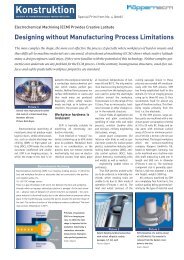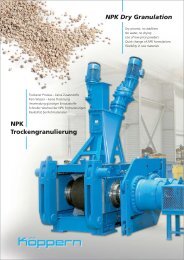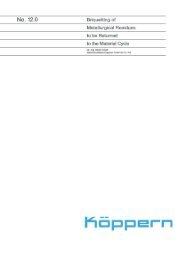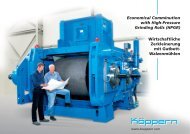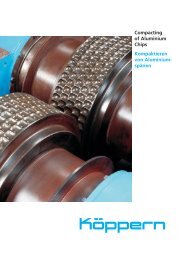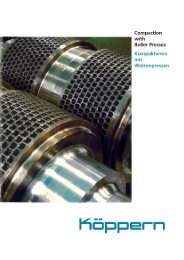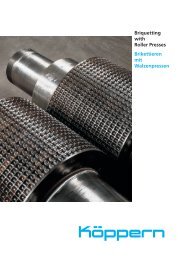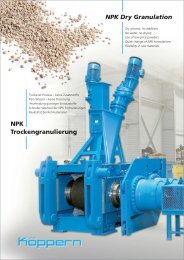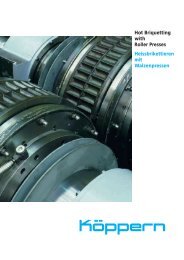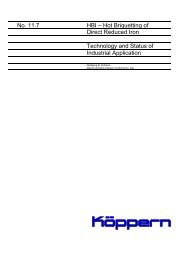Hot Briquetting of Direct Reduced - Maschinenfabrik Köppern GmbH ...
Hot Briquetting of Direct Reduced - Maschinenfabrik Köppern GmbH ...
Hot Briquetting of Direct Reduced - Maschinenfabrik Köppern GmbH ...
Create successful ePaper yourself
Turn your PDF publications into a flip-book with our unique Google optimized e-Paper software.
Today, an increasing number <strong>of</strong> Merchant <strong>Direct</strong> Reduction Plants operates in several<br />
locations. Others are in different stages <strong>of</strong> planning and construction. In these facilities,<br />
premium, "alternative" iron units are produced for export to the world's steel industry.<br />
Because <strong>of</strong> its much better shipping and handling characteristics, HBI gains an<br />
increasing importance for the supply <strong>of</strong> international markets.<br />
In the following, the differences between the two types <strong>of</strong> products are discussed.<br />
<strong>Hot</strong> briquetted iron will be particularly reviewed with regard to:<br />
- Specific advantages and Characteristics <strong>of</strong> HBI<br />
- Equipment and plants for the production <strong>of</strong> HBI<br />
- HBI from different <strong>Direct</strong> Reduction Processes<br />
- Development <strong>of</strong> the industrial application <strong>of</strong> HBI<br />
HBI - Why?<br />
Fundamentals.<br />
During direct reduction, oxygen is removed from iron ore in solid state. This procedure<br />
results in a spongy structure <strong>of</strong> the product, thus "Sponge Iron", with a high porosity. Depending<br />
on the raw material and the reduction process applied, apparent product<br />
density is approx. 2 g/cm³ associated with a very high specific surface area. The latter is<br />
typically around 1 m²/g.<br />
Due to the large specific surface area, DRI reacts very easily with water (particularly sea<br />
water) and/or oxygen. Since the reaction is exothermic, heat is produced. Owing to its<br />
spongy structure, DRI is also an excellent insulator. Therefore, the excess heat produced<br />
in a DRI storage pile by, for example, the reoxidation with water does not easily<br />
dissipate. This can cause overheating and meltdown <strong>of</strong> DRI in piles, silos, or - most<br />
dangerously - ship holds. The reaction with water also produces Hydrogen which yields<br />
explosive mixtures with air.<br />
Since the beginning <strong>of</strong> <strong>Direct</strong> Reduction, methods for passivation <strong>of</strong> the product have<br />
been developed and tested. <strong>Hot</strong> briquetting has become the most reliable process for<br />
this task. By applying this technique, direct reduced iron is densified immediately after<br />
reduction at high temperatures and with very high pressures. Industrial facilities in<br />
connection with different <strong>Direct</strong> Reduction Technologies exist already for several years.<br />
Figure 1: Comparison <strong>of</strong> the structure <strong>of</strong> DRI pellets (left) and HBI (right).<br />
2



